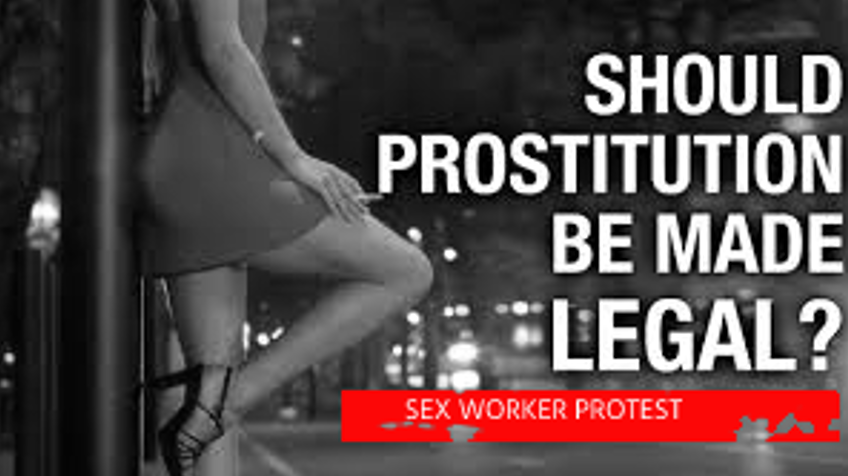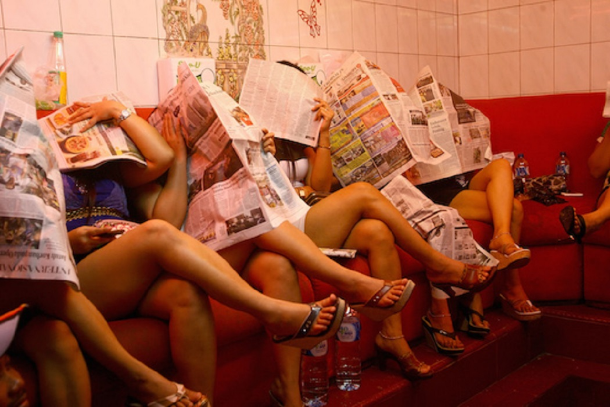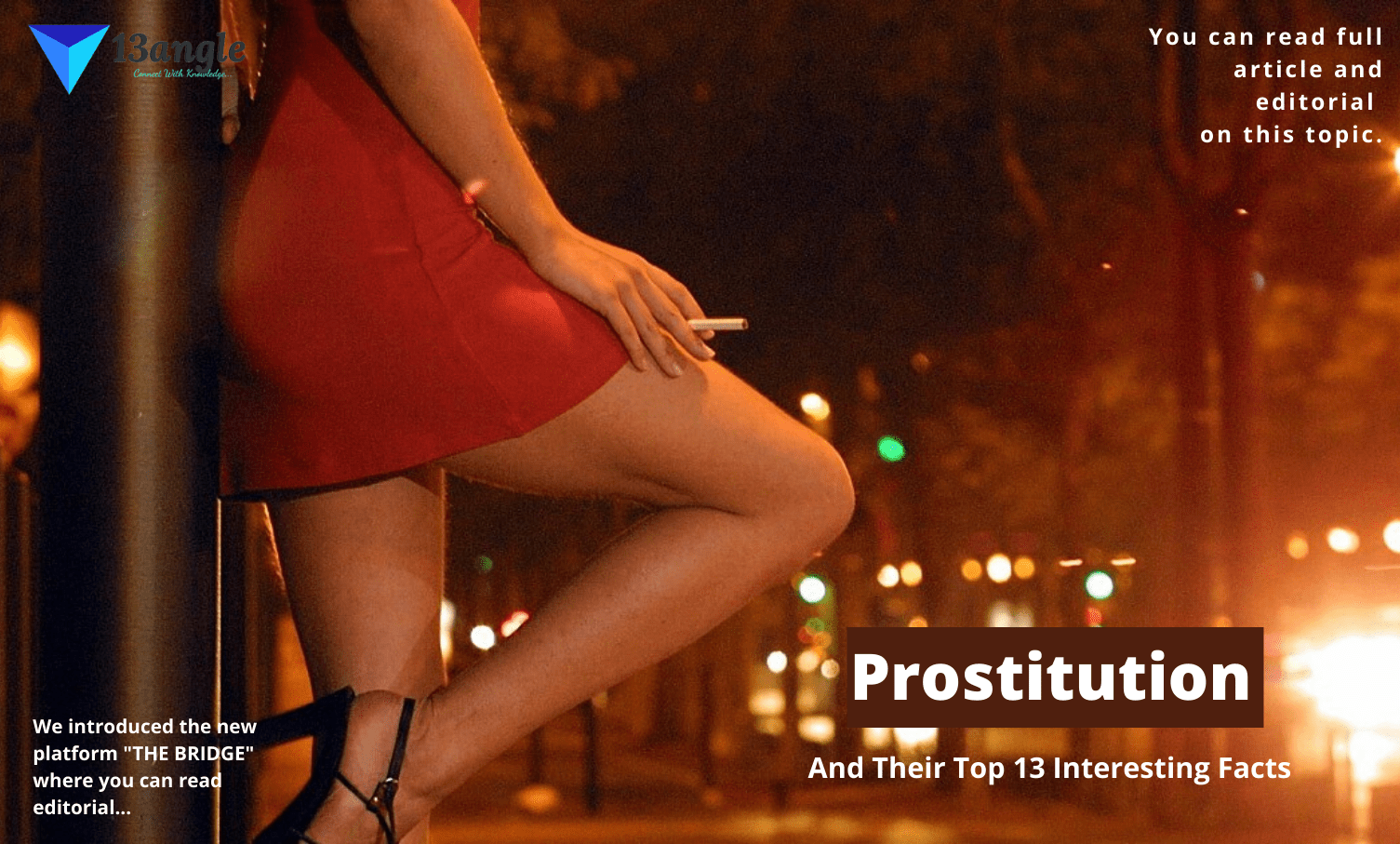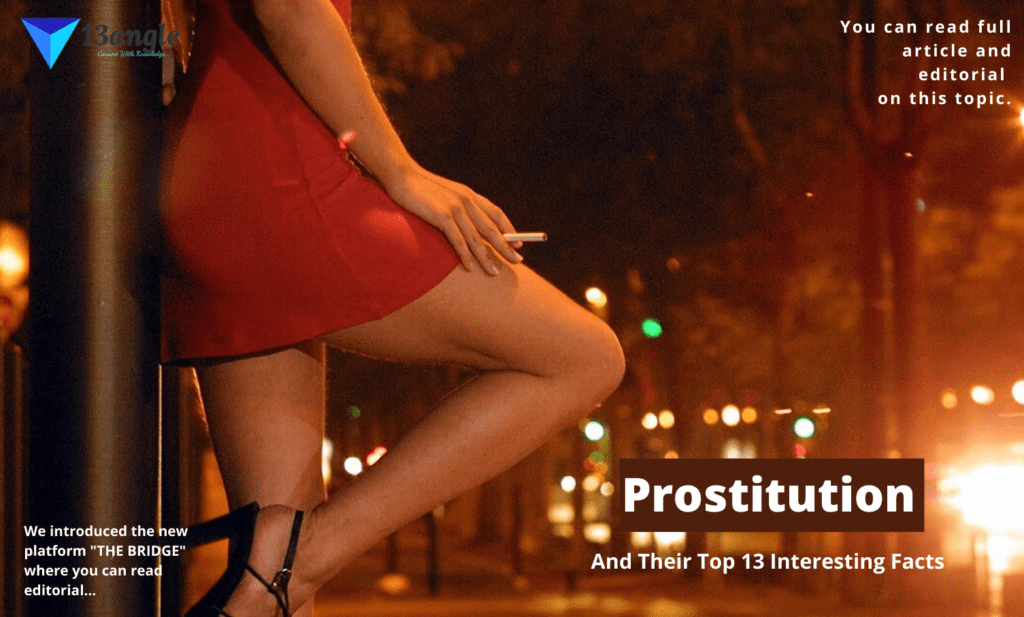- Umang Sagar
- Law, Polity, Recent article
Prostitution

What Is Prostitution?
Prostitution is sex engaged in for monetary exchange rather than for its own sake; it is commercial or mercenary sex – sex as work. Prostitution is a type of sex work that grants the client direct sexual access to the prostitute’s body.
Prostitution In Ancient Times

Prostitution has been practiced for ages. Prostitution has been described as “the world’s oldest profession” although the oldest professions are most likely farmers, hunters, and shepherds. Prostitution was very common in ancient Israel. The mention of prostitution can be found in Hebrew bible. The Biblical story of Judah and Tamar (Genesis 38:14–26) provides a reference of prostitution being practiced in those ages. The Greek word for prostitute is porne (Gr: πόρνη), derived from the verb pernemi (to sell). The English word pornography, is a direct derivative of the Greek word pornē (Gr: πόρνη).
Prostitution Problems

Many are engaged in prostitution by force, fraud or coercion. Some women need money to support themselves and their children; others need money to support their vice habits. Abuse is a common theme in the lives of prostitutes — many were abused as children, either physically or sexually or both. Prostitution also to be linked with a host of mental and physical health problems, including HIV, physical injuries, gynecological problems, depression, posttraumatic stress disorder, and increased likelihood of suicide attempts.
Unemployment, illiteracy, and poverty are reasons for prostitution. Prostitution encompasses one gender’s taking advantage of its superior social status and exploiting the other gender
Effects Of Prostitution On Society & Individuals

Prostitution glorifies the objectification of women: Just because someone pays does not erase the fact of what we consider sexual violence, domestic violence, and rape. However, people who pay for sex tend to think that what they do is acceptable. Prostitution has been convicted as a single form of human rights abuse, and an attack on the dignity and worth of human beings. Other schools of thought depict that sex work is a legitimate occupation, whereby a person trades or exchanges sexual acts for money and/or goods.

Prostitution is legal in India. A number of adjuvant activities including soliciting, curb-crawling, owning or managing a brothel, prostitution in a hotel, child prostitution, pimping and pandering are illegal. UNAIDS estimate there were 657,829 prostitutes in the country as of 2016.
The principal cause of prostitution is poverty. Poverty also becomes a cause of desertion. This rejection makes children to leave their family environment to become street children. Vulnerable and in need of money, they are the main targets of operators who promise them work and remuneration.

A red-light district or pleasure district is a part of an urban area where a concentration of prostitution and sex-oriented businesses, such as sex shops, strip clubs, and adult theaters, are found. The term red-light district originates from the red lights that were used as signs for brothels.
Worldwide there is an estimation of 40-42 million prostitutes. 80 percent of the world’s population of prostitutes are female and range in age between 13-25. 90 percent of all prostitutes are dependent on a pimp.
A tawaif was a courtesan who emerged in India, particularly during the Mughal era. The tawaifs excelled in and contributed to music, dance (mujra), theatre, and the Urdu literary tradition, and were considered an authority on etiquette. Tawaifs were largely a North Indian institution central to Mughal court culture from the 16th century onwards and became even more prominent with the weakening of Mughal rule in the mid-18th century. They contributed significantly to the continuation of traditional dance and music forms and then the emergence of modern Indian cinema.

An appealing type of performing art known as nautch rose to prominence during the later period of the Mughal Empire and the rule of the British East India Company. During the period of Company rule (and after the Indian Rebellion of 1857, the direct administration of the British Crown), British military elements established and maintained brothels across the Indian subcontinent. The prostitutes who worked in such brothels were recruited from rural Indian families and paid directly by the British authorities. The red-light districts of cities such as Mumbai developed at this time.
Profession Types
=> Professions sometimes related to prostitution;
1. Nochi- Young female trainee under a Tawaif
2. Kanjari- Low-class uncultured Tawaif
3. Kasbi- A female belonging to a family which practices hereditary sex trade over several generations
4. Nautch girl- Assorted dance performer during colonial India for all classes of people
5. Tawaif- An elegant and cultured courtesan who is Master of Arts, including singing and dancing Other related often misunderstood but traditionally/originally non-prostitution professions
6. Devdasi- Temple dancer devoted to the practice of spiritual dancing
7. Domni- A hereditary female singer
Government organizations like MDACS (Maharashtra District AIDS Control Society) have played a very prominent role in generating awareness on HIV/AIDS through the assistance in providing free works and organizing street campaigns. There are several NGOs that feed on funds for protecting STI/STDs spread to common population NACO (National AIDS Control Organization), a government agency leads these NGOs. The Durbar Mahila Sumanwua Committee is a sex-workers union based in Sonagachi, Kolkata, which has 65,000 members. They advocate for labor rights for sex workers, and they also fight against trafficking.

The Immoral Traffic (Prevention) Act, or ITPA, also called the Prevention of Immoral Trafficking Act (PITA) is a 1986 amendment of legislation passed in 1956 as a result of the signing by India of the United Nations’ declaration in 1950 in New York on the suppression of trafficking. The act, then called the All India Suppression of Immoral Traffic Act (SITA), was amended to the current law. The laws were intended as a means of limiting and eventually abolishing prostitution in India by gradually criminalizing various aspects of sex work. The main points of the PITA are as follows:-
Sex Workers: A prostitute shall be prosecuted. Similarly, call girls can not publish phone numbers to the public. (imprisonment up to 6 months with fine, point 8)
Sex workers are also punished for prostitution near any public place or notified area. (Imprisonment of up to 3 months with fine, point 7)
Clients: A client is guilty of making contact with prostitutes and can be charged if he engages in sex acts with a sex worker within 200 yards of a public place or “notified area”. (Imprisonment of up to 3 months, point 7) The client may also be punished if the sex worker is below 18 years of age. (From 7 to 10 years of imprisonment, whether with a child or a minor, point 7)
Pimps and babus: Babus or pimps or live-in lovers who live off a prostitute’s earnings are guilty of a crime. Any adult male living with a prostitute is assumed to be guilty unless he can prove otherwise. (Imprisonment of up to 2 years with fine, point 4)
Brothel: Landlords and brothel-keepers can be prosecuted, maintaining a brothel are illegal. (From 1 to 3 years imprisonment with fine for a first offense, point 3) Detaining someone at a brothel for the purpose of sexual exploitation can lead to prosecution. (Imprisonment of more than 7 years, point 6).
Prostitution in a hotel is also a criminal offense.
Procuring and trafficking: A person who acquires or attempts to procure anybody is liable to be punished. Also, a person who moves a person from one place to another, (human trafficking), can be prosecuted similarly. (7 years imprisonment with fine for a first conviction, and up to life imprisonment thereafter; point 5B)
Rescued Women: The government is legally obligated to provide rescue and rehabilitation in a “protective home” for any sex worker requesting assistance. (Point 21)

Mumbai and Kolkata (Calcutta) have the country’s largest brothel-based sex industry, with over 100,000 sex workers in Mumbai. It is estimated that HIV among prostitutes has largely fallen, in the last decade.
A positive outcome of a prevention program among prostitutes can be found in Sonagachi, a red-light district in Kolkata. The education program targeted about 5,000 female prostitutes. A team of two peer workers carried out outreach activities including education, condom promotion, and follow-up of STI cases. When the project was launched in 1992, 27% of sex workers reported condom use. By 1995 this had risen to 82%, and in 2001 it was 86%.
India is a source, destination, and transit country for women and children subjected to sex trafficking. Most of India’s trafficking problem is internal, and those from the most disadvantaged social strata—economically, members of tribal communities—are most vulnerable. Thousands of unregulated work placement agencies reportedly lure adults and children under false promises of employment into sex trafficking.
Experts estimate millions of women and children are victims of sex trafficking in India. Traffickers use false promises of employment or arrange sham marriages within India or Gulf states and subject women and girls to sex trafficking. In addition to traditional red-light districts, women and children increasingly endure sex trafficking in small hotels, vehicles, huts, and private residences.
The scope of limited sex education in schools makes it clear that sex is viewed as a taboo in countries like India. And, in a social and cultural context that makes sex taboo, legalizing sex work is almost offensive. Despite India’s rich historical legacy of the deliverance of female empowerment, extending as far back as ancient and medieval Buddhist literature that celebrated prostitutes who rose up to be monks (Amrapali), the inherent notion underlying sex work inspires widespread disgust and abhorrence.
The legalization of sex work itself remains a challenge. For example, one option for legalized sex work could make use of urban zoning centers where prostitution is. Alternatively, sex workers could be licensed, but this could promote discrimination and bias on the basis of identity (e.g., caste) and infringe on the sex workers’ privacy. In the face of growing support for the legalization of sex work, critics worry about the ignorance of legalization’s true consequences. Studies show that most female sex workers enter into prostitution out of necessity, not a personal choice. We might wonder whether continued criminalization that keeps workers trapped is justifiable when we could instead focus on helping sex workers escape prostitution. Licensing or some other certification of sex work that adds to their résumé would be conventionally considered a possible blot on their record.
A second issue focuses on the risk that legalization might increase human trafficking. Greater legitimacy for sex work could lead fuel that sector’s economy, yet sex workers would likely not benefit from such growth. Most sex trafficking networks operate in a shadow economy, and the profits are concentrated beyond the sex workers’ reach. We should be mindful that legalization alone would not in itself transfer profit to lower reaches.
Lastly, sex work is still a fairly unorganized sector with many women operating from their homes. Legalization would push many workers outdoors, and further stigma would soon follow. Some neighbors may forbid sex workers from living nearby. Those sex workers too restrained to come forward would also be excluded from the protections of labor law under a legalization scheme.
Legalization is therefore argumentative. But legalization’s only alternative may be exploitation. In the face of growing support for the legalization of sex work, critics worry about the ignorance of legalization’s true consequences.
Prostitution: What Are The Problems And How Do We Solve Them?
Prostitution doesn’t happen by itself. It’s part of an operational problem, like plastic in the oceans.
We won’t succeed in reducing the harms of plastic unless we address the whole system and change our behavior and attitudes.
Sex inequality is not just an economic problem. We’re observing epidemic levels of male violence against women and children.
Men had always subordinated women that act as collective dominance. It’s a form of mass bullying that’s effectively sanctioned by society.
Why hasn’t male violence against women and girls been declared a national emergency?
here’s evidence the rise in male violence is connected with the unprecedented availability of porn, and the misogynistic violence with which it’s infused.
Studies depict that men who buy sex find they enjoy the lack of emotional involvement, and see the women they use as objects.
When the government overlooks women having to turn to prostitution to survive, prostitution becomes the welfare system, and motivation is lost for striving for real, positive solutions to women’s poverty and fixing the broken benefits system.
The best way to minimize prostitution’s harm to both the individual and society is:
To cancel all the laws that target prostituted individuals, and to clear their criminal records for the same, while introducing ring-fenced funding for high-quality non-judgmental services, including genuine routes out and viable alternatives.
Effective laws should be implemented against pimping, sex trafficking, and brothel keeping
To make purchasing sex a criminal offense, with the key aims of changing attitudes and reducing the demand for prostitution that drives sex trafficking.
Steps That Should Be Taken In Order To Fight With Prostitution

Formal education should be made available to those victims of prostitution who are still within the school-going age, while non-formal education should be made accessible to adults through online learning.
vocational training should be given to all those rescued victims who are not interested in education.
Rehabilitation of rescued victims being a long-term Recruitment of an adequate number of trained counselors and social workers in institutions/homes run by the government independently or in collaboration with non-governmental organizations
Awareness generation on economic rights, particularly for women and adolescent girls should be taken up prostitution.
Culturally sanctioned practices like the system of devadasis, jogins, bhavins, etc. which provide a pretext for prostitution should be banned.
Benefits Of Legalizing Prostitution Are
- The legalization of prostitution and the sex industry will stop sex trafficking.
- Legalization of prostitution will control the sex industry.
- The legalization of prostitution will decrease clandestine, hidden, illegal, and street prostitution.
- Legalization of prostitution will protect the women in prostitution as they will have rights.
- Legalization of prostitution will promote women’s health as they can have easy access to medical facilities which they don’t have when it is illegal.
Conclusion

India should legalize prostitution which is the most suitable step that can be taken or shall make such preventive laws as to curve up the problem of prostitution. Laws should not be such as to just remove the prostitutes but also to change the mentality of people who are interested in paid sex by punishing them in such a manner that people of the same mentality will dare to indulge themselves in similar activities.
Top 13 Interesting Facts About Prostitution
Prostitution is legal in India. A number of related activities including soliciting, kerb crawling, owning or managing a brothel, prostitution in a hotel, child prostitution, pimping are illegal.
Prostitution also appears to be linked with a host of mental and physical health problems, including HIV, physical injuries, gynecological problems, depression, posttraumatic stress disorder, and an increased likelihood of suicide attempts.
Many are recruited into prostitution by force, fraud, or coercion. Some women need money to support themselves and their children; others need money to support their drug habits. Abuse is a common theme in the lives of prostitutes — many were abused as children, either physically or sexually, or both.
Prostitution, the selling of sexual services, is yet another controversial sexual behavior. Many people, and especially those with conservative, religious views, believe prostitution is immoral because it involves sex for money, and they consider prostitution a sign of society’s moral decay.
Prostitution is no longer seen as the most extreme moral depravity a woman is capable of; but the view that it is at least seriously morally flawed, if not repugnant and intolerable, is still widely held.
8 million sex workers in India.
The average age of a sex worker in India is 18.
One out of ten men pay to have sexual interaction with sex workers.
Prostitution is a booming industry.
75% of sex workers face physical and psychological abuse.
80% of sex workers are raped.
Prostitution is sexual exploitation, not sexual liberation.
80% of the sex workers are raped.



